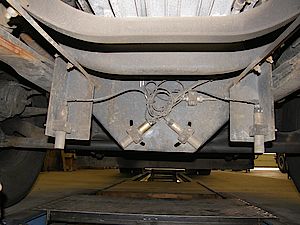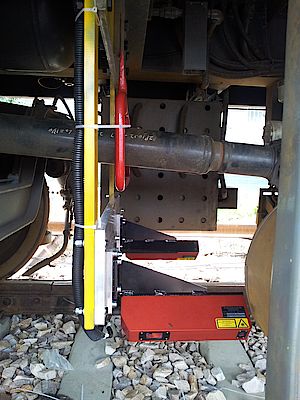Vehicle Compensation
The non-contact contact wire position measuring system OVHWizard detects the height and stagger of the contact wire in relation to the installation site of the measuring system. This is generally 3-4 m above the top of rail on the roof of the vehicle or to a holder of an appropriate height.
The movements of the vehicle in the track while driving affect the measured value more or less according to the suspension. To compensate this impact, the movements of the vehicle will be compensated either by 5 ultrasonic sensors or 2 laser scanning sensors in a horizontal direction (gauge clearance), in the vertical direction (height movement) and the rolling of the vehicle (rotation of the superstructure to the vehicle axis of rotation). Which system is used depends on the structural design of the vehicle.
Both systems generate compensation which that are forwarded directly to the contact wire measuring system OVHWizard. In the OVHWizard the actual measuring values will be corrected online with the compensation data.
The compensation unit will be delivered as a compact unit in a control cabinet with the protection class IP 69 k. In agreement with the client the sensors will be mounted on a mounting panel under the vehicle (option).
The exact installation place has to be determined with the vehicle manufacturer or operator and in a simulation is to verify that the sensors under all driving conditions (e.g. different curve radii) capture the surface of the rail.
Ultrasonic compensation
From the 5 ultrasonic sensors, two sensors detect the horizontal movement in the track, two additional sensors detect the height movement and the rolling motion of the vehicle. The fifth sensor is used to compensate the temperature dependence of the ultrasonic measurement.
Laser compensation
The two sheets of light sensors detect the complete rail profile until above the running surface.
With a vehicle movement in the track the position of the rail relative to the sensors are shifted or twists. From this change in position, the software determines the three vehicle movements’ height and lateral position and the rolling of the vehicle.


